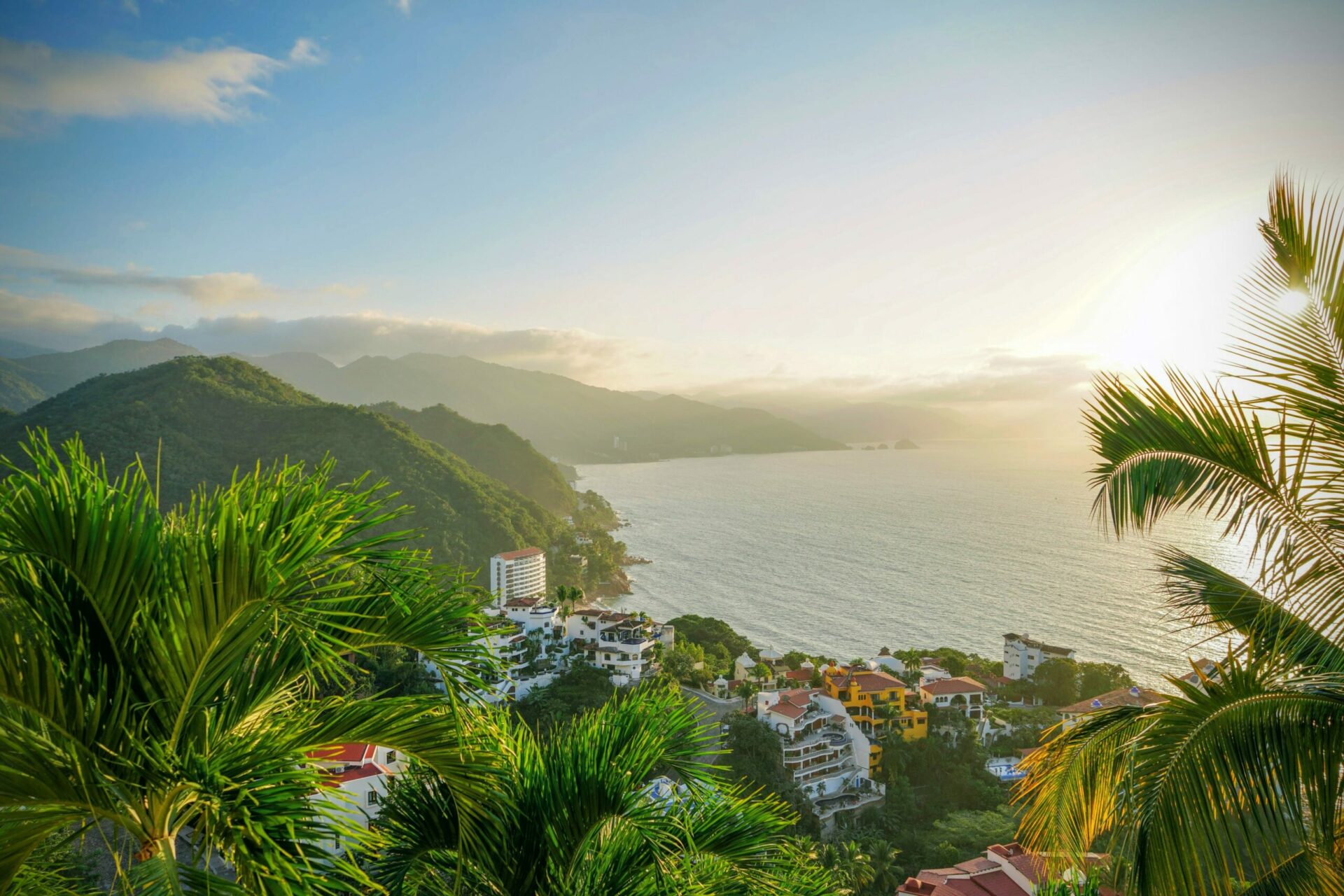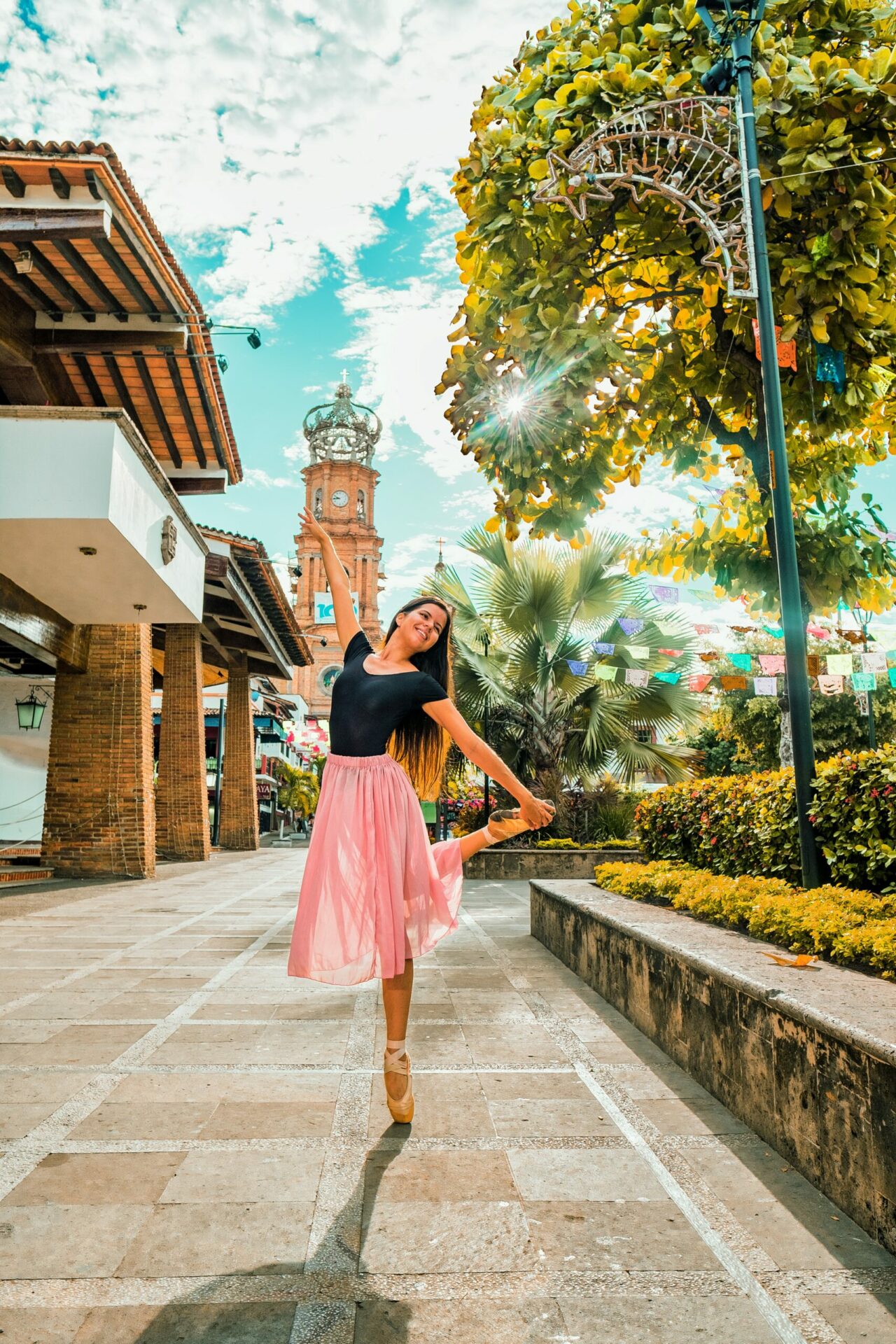Living in Puerto Vallarta: Bliss on the Bay of Banderas
Table of Contents
Puerto Vallarta history began with the Spanish. The Bay of Banderas was frequented by the Spanish in the 16th century to repair their ships and resupply them with water, firewood and fresh food. During that time, ports along Mexico’s western coast were essential to Spain for their colonization of South America and the Philippines. Safe harbors like the Bay of Banderas also helped protect the Spanish fleet from pirates who roamed the seas.
Today, Puerto Vallarta is the sixth largest city in the state of Jalisco and his home to over 300,000 people. It is now the third largest vacation destination in Mexico and host to nearly 2 million visitors each year. The Puerto Vallarta lifestyle is a blend of laid-back beach town ambience and international resort living wedged between tropical green mountains and the deep blue Bay of Banderas. The locals call it PV or just Vallarta and it is known widely as the “Jewel of the Mexican Riviera.”
Get new listings in your inbox.
Get new listings in your inbox.
The Geography and Best Areas in Puerto Vallarta
Puerto Vallarta is wedged between the Sierra Madre Occidental Mountains and the Bay of Banderas in the Mexican state of Jalisco. The Bay of Banderas, or Bay of Flags in English, is Mexico’s largest natural bay and has over 50 miles of shoreline.
The city sits on a narrow coastal plain that widens to the north, reaching its widest point along the Ameca River, which separates the state of Jalisco from the state of Nayarit. Three rivers – the Ameca, Cuale and Pitillal – flow from the mountains to the bay.
Beyond Puerto Vallarta, a number of smaller villages and towns ring the Bay of Banderas, from Cabo Corrientes on the southwest tip of the bay to Punta Mita on the northwest tip.
Puerto Vallarta has many Colonias (neighborhoods) but mainly is divided into three major districts.
The hotel zone stretches along the bay from the downtown area north to the international airport and is lined with hotels, condominiums and shopping centers. You will find all of the major brand name hotels and familiar retailers like Walmart and Costco in this area. On the northern end of the hotel zone is Puerto Vallarta’s marina. Residential housing spreads east from the hotel zone to the mountains.
Centro is the downtown shopping and dining area just south of the hotel zone and north of the Cuale River. The city’s mile-long malecon (boardwalk) separates the bay from Centro’s charming cobblestone streets and shops. Puerto Vallarta’s iconic Our Lady of Guadalupe church rises above shops and homes that climb up the side of the hills above Centro.

On the south side of the Cuale River, Zona Romantica, or the romantic zone, is known for its shopping and laid-back beachfront restaurants. The malecon crosses the Cuale on a footbridge and spills into a row of condominiums, restaurants and shops that stretch beyond Playa Los Muertos beach. South of Zona Romantica, some of the most desirable condos and homes in Puerto Vallarta are strung along the southern beaches and up the hillsides overlooking the bay.
Like most of mainland Mexico, Puerto Vallarta observes Central Standard Time, including many of the cities on or near the Bay of Banderas in the Mexican state of Nayarit. When you cross the Ameca River just northwest of the international airport you will be in the state of Nayarit. Puerto Vallarta and the Bay of Banderas area switches to daylight saving time the first Sunday in April and returns to Central Standard Time the last Sunday in October.
Things to do in Puerto Vallarta
For expats, PV is more than just its magnificent beaches and tourist attractions. The city also is well known for its restaurant scene and a variety of social and cultural events, from concerts to local charity benefits to the annual Puerto Vallarta Film Festival.
If you love the beach, there are plenty of places to love starting with Playa de Los Muertos in Zona Romantica. This is the city’s main beach Vallartans share with visitors. If you get hungry, just amble over to one of the many excellent beachside restaurants.
Farther north, the hotel zone between Centro and the international airport has long strands of beach, but if you are looking for those wide expanses of golden sand that you see in travel brochures, look no farther than the beaches of Nuevo Vallarta and points north. If you love surfing, try the beach in Sayulita. The drive from PV is less than an hour and the town is laid-back fun.

Consider also the beaches south of the city at Mismaloya and Conchas Chinas, as well as the beaches that line the southern shore of the bay, like Yelapa. To access those beaches, though, you will need to take a water taxi or rent a Panga (a small motorboat). Bay cruises also stop at Yelapa for an hour or two each day.
A popular snorkeling spot is Los Arcos National Marine Park, about a 7-mile drive south of PV. You can also whale watch from mid-December through the end of March and often spot dolphins and sea lions.
The Bay of Banderas is Puerto Vallarta’s playground. Any day of the week you can surf fish and deep-sea fish, swim, surf, sailboard, kiteboard, snorkel, scuba dive, kayak, sail and ride a jet ski on Mexico’s largest natural bay. Some of the newer activities include paddle boarding, fly boarding, kite boarding and ziplining. Sitting on the beach sipping a margarita is always a welcome alternative.
If you are a tennis player or golfer, there are a number of excellent courts and courses that ring the bay, including nearly a dozen golf courses, several world-class.
Expats in PV often lead a very active social life. Many belong to the city’s numerous charities, which activities include visiting local hospitals and rural communities to deliver toys to children on January 6 in celebration of El Dia de Los Tres Reyes Magos, or Three King’s Day. Other organizations favored by local expats provide scholarships to high school and university students who have limited resources and high scholastic achievement, and who attend public high school and university in Vallarta. These charities hold events throughout the year.
Another cultural event to observe is Dia de Los Muertos, or the Day of the Dead Festival, which is held at the end of October and the first few days of November. This is when the city of Puerto Vallarta honors the dead and celebrates the life of those who have passed.
Puerto Vallarta also has a well-earned reputation for the quantity and quality of its restaurants. From street-side fish taco stands to upscale dining, you can find just about anything you want at whatever price you are willing to pay. Some of the finest dining can be found in and around the downtown area. Restaurants like Maximillian, Trio and Café des Artiste are elegant and fabulous. Newcomers such as Tre Piatti, Pulpito 116, Boccon di Vino, The Swedes and Mestiza are giving the old favorites a run for their money. But if watching the sun sink slowly and romantically over the bay is your thing, beach restaurants Daiquiri Dick’s and La Palapa in Zona Romantica are hard to beat.
If you are an adventurous eater, try the local pescado embarazado (no, it is not an embarrassed fish). It is fish — usually school shark or marlin — roasted on a stick and served with Salsa Huichol. Also try Birria, which is goat or lamb meat boiled in a picante sauce consisting of cumin, oregano and ginger. It is served with lime, onions and tortillas. Another great dish to try is torta ahogadas, which translates to “drowned sandwiches.” It is made with birote, a local white bread, stuffed with pork pieces (or other meats) drowned in spicy chili and tomato sauce.

Day-to-day shopping for food, clothing, furniture and other consumer products is easy in PV. The large “big box” stores and shopping malls mostly are located in the hotel zone, the marina and Nuevo Vallarta. More traditional Mexican goods are sold in shops and mercados in the city center.
Plaza Galerias Vallarta – a sprawling mall with many stores and a wide variety of consumer choices – and Walmart and Sam’s Club are located across from the cruise ship port in the northern part of the hotel zone. A little farther south in the hotel zone is another large shopping center, Plaza Caracol. Just a few blocks from Plaza Caracol is Costco. Plaza Marina is in Marina Vallarta and the Paradise Plaza shopping center is located in Nuevo Vallarta, about 15 minutes west of the international airport.
If you are looking for local goods and fresh foods, try the public markets in Centro and Mercado Isle Cuale and Mercado Municipal Cuale on or near the Cuale River. All of the major Mexican supermarkets like Soriana and Ley are well represented in PV.
Finally, if you are an art lover, you will love Puerto Vallarta. The city has several art walks each year to show off its wide range of top-notch galleries. Most are located in Centro and Zona Romantica.
Puerto Vallarta is a very desirable place to live in Mexico with its tropical climate, beautiful beaches and vibrant restaurant scene. But Puerto Vallarta cost of living can be higher than other places in Mexico mainly because of the nearly 2 million tourists that visit the city each year. However, compared with most U.S. cities, it is still much less expensive.
Your cost of living in Puerto Vallarta will depend upon the type of lifestyle you want to have and may be similar to what you left in your home country, if you want to maintain a the same kind of lifestyle.
Puerto Vallarta Cost of Living
Puerto Vallarta is a very desirable place to live in Mexico with its tropical climate, beautiful beaches and vibrant restaurant scene. But Puerto Vallarta cost of living can be higher than other places in Mexico mainly because of the nearly 2 million tourists that visit the city each year. However, compared with most U.S. cities, it is still much less expensive.
Your cost of living in Puerto Vallarta will depend upon the type of lifestyle you want to have and may be similar to what you left in your home country, if you want to maintain a the same kind of lifestyle.
To compare the cost of living between Puerto Vallarta and where you live, visit Expatistan or Numbeo, two popular crowd-sourced cost of living websites.
Puerto Vallarta Education
Puerto Vallarta education offers expats a range of options, including public schools, bi-lingual private/international schools and homeschooling.
The public school system in Mexico is overseen by the Secretariat of Public Instruction (Secretaría de Educación Pública, SEP). Attendance is mandatory for all students ages 6 to15. Basic education includes pre-primary school for children 3 to 5, elementary school for children 6 to 12 and secondary school for those 13 to 15.
Students at the age of 16 are given the option to continue schooling at the high school level. There are two possible degree options. The first is a qualified technician degree, or profesional tecnico, which is chosen by less than 10 percent of all students. The other is a high-school diploma, or bachillerato, a much more popular option.
The school year in Mexico starts in mid-August and ends in the first days of July and, by law, must cover 200 days.
If you decide to enroll your child in the local school system, you can find more detailed information at the PV Angels website.
Many expats opt to enroll their children in international schools, such as the American School of Puerto Vallarta. International schooling is provided for students from elementary school through post-compulsory school. American college entrance examinations (SAT, ACT and AP) and/or British GSCE A-level examinations are available through most international schools. Many international schools also offer either the globally recognized International Baccalaureate (IB) Program or the Cambridge IGCSE and instruction generally is conducted in English and Spanish. Certification from these schools is accepted worldwide for university entrance.
For a complete list of private/international schools in Puerto Vallarta visit the PV Angels website.
Homeschooling is another option for expats in Puerto Vallarta. There are no laws prohibiting homeschooling in the country, if you choose to do so. You can find out details at this Home School Legal Defense Association (HSLDA) website.
Transportation in Puerto Valllarta
Puerto Vallarta is a city of over 300,000 people and is sandwiched between the Sierra Madre Occidental Mountains to the east and Banderas Bay to the west, which means that traffic routes through the city are limited. Puerto Vallarta transportation can be a problem, especially if you are driving. Parking is hard to find in Centro and Zona Romantica, even with the construction of multi-floor parking garages.

Buses are an inexpensive and reliable way to get around the city. Three bus companies cover most of the city and generally run from 6 a.m.-11 p.m. Traveling in the wee hours of the night? No problem, there are night-owl buses called “servicios buho” from 11 p.m. – 6 a.m.
Bus fares are for one-time use only and there is no change available on board, so make sure you have exact change. You should be able to go most anywhere for about US$.50. Keep your ticket in a safe place so the inspectors can check that you have a ticket.
Also be sure that you are taking the correct bus. Buses that are marked Centro go through different neighborhoods to make their way downtown. Buses marked Tunnel also go through different neighborhoods in the city and end up downtown.
Buses also connect Centro and Zona Romantica with outlying areas. Buses that are marked Ixtapa, Las Palmas or Mojoneras connect the downtown area with those towns. Buses marked Mismaloya connect expats living south of Puerto Vallarta with downtown. And, buses marked Marina Vallarta also provide easy access to the central part of the city from the hotel zone.
For trips to outlying destinations, Greyhound or Autotransportes (ATM) buses can take you to Nuevo Vallarta, Bucerias, La Cruz de Huanacaxtle, Punta Mita, Sayulita and points north. Service runs from 6 a.m.-11 p.m. and generally is available every 5-10 minutes.
Taxis are also plentiful and relatively inexpensive compared with U.S. taxi fares, although higher than most inland cities in Mexico. They do not use meters, instead charging per ride based on zones in the area. Local taxis are yellow and fares differ depending on distance travelled.
If you would like to spend the day in Yelapa or other villages on the southern shore of the bay, you can use a water taxi. They leave from the pier at Playa de Los Muertos or farther south in Boca de Tomatlan. Prices vary depending on destination. Water taxis also link La Cruz de Huanacaxtle and Nuevo Vallarta with Puerto Vallarta.
Saftey in Jalisco
Puerto Vallarta safety is quite good since it is a major tourist hub. The U.S. Department of State says that crime in Mexico varies widely by location with the worst crime reported in the states that border the United States and the south of Mexico, mostly because of drug cartel activity.

Homicides and other serious crimes are infrequent in major international resort cities like Puerto Vallarta, although the U.S. government has issued travel warnings for other areas within the state of Jalisco, primarily on its borders with the states of Michoacan and Zacatecas.
Crime such as burglary, pickpocketing and vandalism can occur at any time but is worse during major public and religious holidays in Mexico, like Semana Santa, the celebration of Holy Week at Easter when Puerto Vallarta is filled with tourists from Mexico and other countries.
You can stay updated on travel warnings and safety information at this U.S. Department of State website.
Healthcare in Puerto Vallarta
Puerto Vallarta healthcare is excellent. The city’s status as an international beach resort has attracted many top quality doctors and dentists who provide a wide range of medical and dental services at a reasonable price, compared with similar services in the U.S. and other developed countries.
For such a small city, Puerto Vallarta has excellent hospitals, clinics, emergency and ambulance services and evacuation services. English is widely spoken in the city.
For hospital care, Puerto Vallarta has several good options.
Hospital Joya in the hotel zone is a level-one trauma center and has emergency room and ICU staffing 24-hours each day. Medical equipment and technology is considered the best in Puerto Vallarta, including MRI, CT scans and dialysis. Hospital San Javier Riviera is located in Nuevo Vallarta to serve the north bay.
Vallarta Medical Center is a state-of-the-art level-four trauma center located in the city’s hotel zone. Equipment includes CT scans and MRI.
CMQ Premiere Hospital, just east of the hotel zone, and Hospital Medasist in Zona Romatica are also recommended. Both can provide CT scans.
All hospitals in Puerto Vallarta offer emergency evacuation services and have English-speaking staff. Hospitals require payment in full at checkout. Most take major credit cards.
Dental services are also plentiful with a wide range of options and local dentists.
For both doctor and dentist recommendations, rely on expats currently living in Puerto Vallarta. You can find them on the Expats In Mexico Facebook page or other Facebook pages focused on Vallarta expats.
